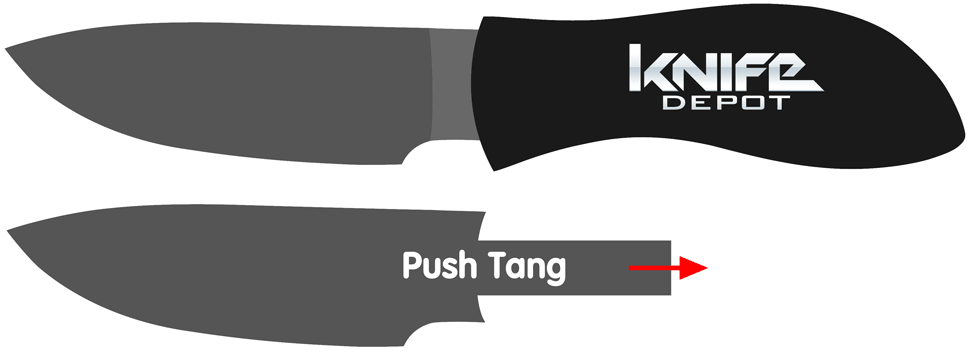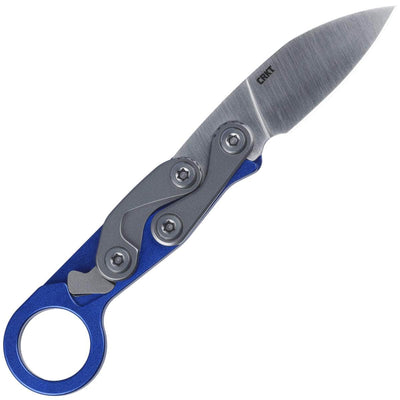Your cart is empty.
All About Knife Tangs

To non-knife nuts, tang is simply a powdered drink famous for its excursion into space. To the knife obsessed, a tang is one of the most important characteristics on a fixed-blade knife.
In simplest terms, a knife tang is the bottom portion of a blade that extends down into the handle. It's essentially the backbone of a knife because it's what holds the whole thing together. Without a tang, a fixed blade would fail when any force is applied because there would be nothing to attach the blade to the handle.
Many different terms are used to discuss the type of tang found in a blade, which we'll discuss below, but it should be noted that some of these descriptions aren't mutually exclusive. For example, you can have an encapsulated stick tang.
Let's kick off the discussion with the two major types of tangs: full and partial.
Full Tang
The first major category is the full tang, which extends the entire length of the handle. (Note: While the technical definition of a full tang only involves a tang that extend the length of a knife, pretty much everyone also refers to a full tang as one that extends the length and width.)

Pros
Generally speaking, a full tang is the strongest tang construction (though everyone should know by now that there are no such things as absolutes). The main reason is that a full tang incorporates the most amount of steel into the handle, meaning it's less likely to bend or fail while in use.
A tang extending the length of the handle not only gives the user more leverage but also better balance, since the knife's balance point will typically fall toward the middle.
If a knife is used in lifesaving operations or survival situations, a full tang knife is highly recommended.
Cons
What's the major downside of having such a strong knife? The weight. Since a full tang uses the most amount of steel in the handle, it increases the overall weight of the knife. However, many skilled knifemakers will defray this increased weight by tapering the tang toward the butt (more on this later).
Examples
Partial Tang
A partial tang is the other major category and covers those that are not full tangs. Essentially, this is a tang that does not cover the entire length of the handle. You might sometimes hear a partial tang referred to as a half tang, stub tang, three-quarter tang, or even push tang (which is also another type of tang characteristic we'll get to next).

Pros
In the past, knife enthusiasts would scoff at the partial tang for its lack of strength, but improved manufacturing techniques and better epoxies have led to an array of well-made partial tang knives and a general change of opinion.
Unlike a full tang, which uses more material and is therefore heavier, a partial tang has an extremely light handle. This makes it less burdensome to carry but also pushes the balance of the knife toward the blade. A partial tang gives the opportunity to use a wider variety of handle materials that may be more difficult to work with (like stag).
Cons
Since a partial tang has less material in the handle, it does not have the same amount of leverage and is more prone to breakage in extreme conditions. To be clear, a partial tang will typically not fail under normal, or even really tough, circumstances, but a partial tang will usually fail before a full tang.
Examples
Push Tang
A push tang (sometimes called a rabbeted tang) has less to do with what it looks like than how it is affixed to the handle. This type of tang is pushed directly into a premade handle and fastened in place with an adhesive. It generally doesn't run the full length of the handle, but it can be found on both full and partial tang knives.

Pros
A big advantage of a push tang is that it cuts down on costs because the tang doesn't need to be finished since it's not visible. This is especially true for factory knives.
Cons
Push tangs have often been criticized as weak, but improvements to factory epoxies have made push tangs much more reliable. Still, it does have some limits on how far you can push it.
Examples
Encapsulated Tang
An encapsulated tang is when the handle material is molded around the tang rather than pushing it in. The tang is fitted to the handle.

Pros
The biggest advantage of this method is the strength. Unlike a push tang, which has some potential to fail where the tang meets the handle, encapsulated tangs are stronger and offer more precise control.
Cons
This is a limiting way to construct a tang, which means it won't work well with all types of handle materials.
Examples
Hidden Tang
Description: A hidden tang is fastened to the handle in a way that you can't see the tang or how it's held together. One way to create a hidden tang is to slide the tang through the handle so it's flush against the bolsters and seal it with epoxy. Another way is to make the tang a little longer and use a pommel or buttcap to keep it in place.
This one is a little harder to understand, but Jay Fisher has an excellent explanation of the two types of hidden tangs over at his site.

Pros
One of the obvious upsides to the hidden tang is the appearance. With a hidden tang, you can better showcase the handle material on all sides while maintaining a fair amount of strength.
Cons
These are rarer on factory knives because they're harder to manufacture. While some people say hidden tangs might be as strong as full tangs, this isn't the case. Hidden tangs lose some of their metal and thickness in the construction process. But it should be noted that hidden tangs are quite reliable, and their strength also depends on the knifemaker.
Examples
Rat-tail Tang or Stick Tang
A rat-tail tang, also known as a stick tang, is one of the more drastic knife tangs. The tang uses less stock material and is significantly narrower than the blade, thus giving it the resemblance of a rat. (The blade is the thick body of the rat while the tang looks like the thin tail.) The tang is often secured to the handle with a bolt or threaded pommel.

Pros
This type of tang is most commonly found on show knives or budget that aren't intended for heavy use. Since they use less stock material, these knives are less expensive and significantly lighter.
Cons
Rat-tail tangs are typically thought to be the weakest tangs, being unsuitable for heavy use. However, despite the bad reputation, rat-tail tangs do not have a high rate of failure during casual usage and are even found on bushcraft knives.
Examples
Tapered Tang
A tapered tang, which is sometimes called a tapering tang or narrowing tang, is when the tang becomes increasingly narrow. This can actually describe the thinning of the width of the tang but more commonly refers to the thickness of the tang.

Pros
Tapering of the tang reduces the amount of steel used and therefore reduces the weight without sacrificing too much strength.
Cons
Tapering of the thickness of the tang can be a complicated design that's only accomplished with great success by custom knifemakers. Tapering the width will cause some minor loss of reliability in extreme conditions.
Examples
Skeletonized Tang
A skeletonized tang is when portions of the inside of the tang are missing. This reduces the amount of material in the tang while retaining its structural framework. You'll often find knives with a skeletonized tang featuring a cord-wrapped handle or no handle material at all.

Pros
Removing material from the inside of the tang not only helps retain some of the strength of a full tang but also reduces the overall weight, which can offer a better balance.
Cons
By its very definition, a skeletonized tang will have some weak spots and lose strength, depending on where the holes are made in the tang. The dip in performance and strength are usually negligible.
Examples
Extended Tang
Whereas most tangs end at or before the end of the handle, an extended tang will continue past it. The part of the tang protruding from the handle can be used as a hammer pommel.

Pros
This provides an additional feature to the knife that protects the handle and gives a surface for things like hammering in tent stakes. An extended tang may also have a lanyard hole for extra security.
Cons
There aren't any real downsides to having an extended tang, except for the fact that it might limit the type of handle material a knife can use or get in the way at times.














































